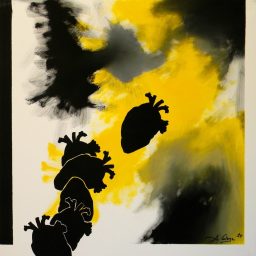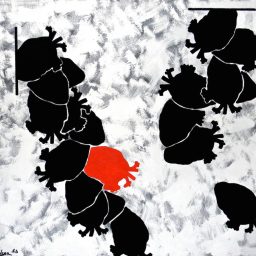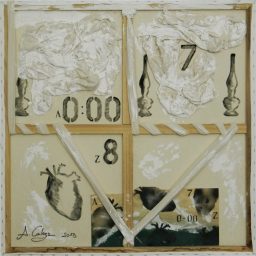In 2008 he dedicated his time to a collection titled “Constellations” , using castings of varnish and tempera on damask canvas, and was committed in the study on that subject until 2011. In 2010, due to personal reasons, he underwent a period of distress, which gave rise for the first time in his painting career to the presence of human bodies. While keeping on his artistic journey in order to find what could best represent him, Alessio Calega approched the world of a free, minimal and simpler painting, which had been born deeply inside the artist in the meantime. His painting style mirrored the tough reality he was living in. Such discomfort was conveyed thanks to the use of household objects and tools taken away from their original contexts to be part of his work of art. Among the several types of emotions that the artist usually displayed in his work, the one which most caught the audience's eye was obsession. In fact, he has been studying upon new techniques since 2012, and finally decided to use stencils in his paintings repetitively, a means which has hepled him portaying his inner torment. He then started the production of a series of paintings inspired by Edgar Allan Poe's short story “The Tell-Tale Heart” that was later displayed in his first Solo Exhibition at the “Teatro Santo Stefano” in Campi Bisenzio (Florence) in 2013. The vernissage was characterised by the performance of an actress reading a monologue on a stage. The whole experience contributed to create a unique meeting point between the hearing and the sight needed to understand the paintings. Those paintings depict the facts of the short story chronologically , making whoever observes them feel the same nightmare as the protagonist of the story does. The obsession, as it was previously outlined, prevails and the reproducibility of the heart and the eye became recurring key symbols to interpret the actual meaning of the artist's production. Another leitmotiv in Calega's work is the concept of “border”. In fact, some hidden lines behind the canvas could be usually found in his paintings. Such lines are meant to draw a limit as well as to gain control over art again. To this day, they have been replaced by the use of the painted frame. In Alessio Calega's current way of painting several hints to his previous techniques can be found, as for example the use of letters and numbers to convey a temporal rythm to the work. What is now changing within his conception is instead something about the colour of the canvas, which has turned to be an almost completely monochromatic background with no contamination of other colours. Alessio is keeping on his research in his studio although he has already found some distinctive and recognisable personal marks as if he had already found his own handwriting, a way to tell the world about his true self. The work of art will then represent the proof of the artist's constraint into every day life and his attempt to find a space for creativity rather than surrender to alienation. To look at one of Alessio's paintings is to stand in front of a deep and touching work which is able to tell either the story of a single experience or that of his entire life, leaving a space for the audience's free interpretation at the same time. Alessio lives and works in Florence.
Events at Rome Art Week
2018
Free access






